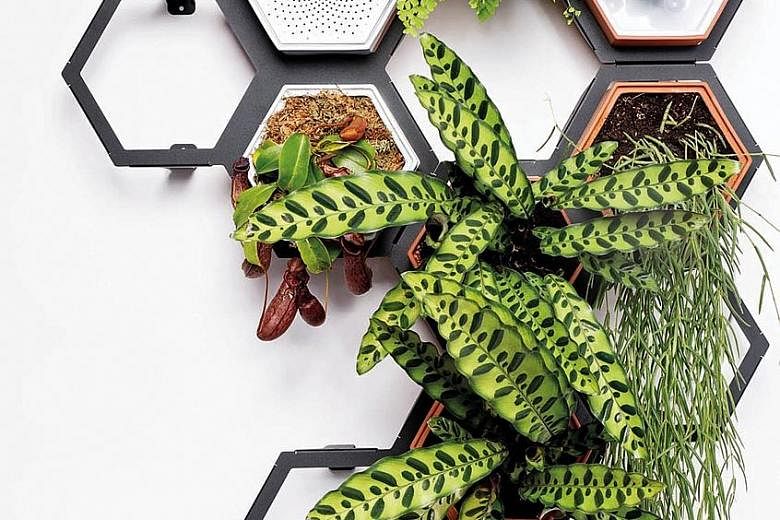Let's face it - agriculture is not an industry people have given much thought to in urban Singapore.
But if you are one of those who decided to start growing your own vegetables during the circuit breaker, you are not alone.
"Growing food at home gives you that feeling of self-sufficiency," says Mr Darren Tan, education and outreach manager at local rooftop farm ComCrop.
"After the experience that a lot of us had during the outbreak - going to the supermarket and finding that the produce is out of stock - most people have realised that growing vegetables at home that they can eat is quite a practical solution."
Growing your own produce is not a new trend. It has been around for some time, but it has been dramatically accelerated by the disruption of supply chains during March and April this year, and a subsequent increase in public awareness of food security issues.
Apart from the practical aspect, growing your own vegetables has other positive effects on your well-being.
Your little patch of greenery does not only add aesthetic value to your home, but it also helps you to be more focused on the present and establish a much-needed sense of control despite the uncertainty of today's turbulent world.
You get bragging rights too, especially if you post pictures of your home-grown strawberries or kale on Instagram.
Yes, it is now possible to grow varieties beyond the usual herbs and leafy vegetables that flourish in Singapore's hot and humid climate, thanks to the advancement of hydroponics.
Soil or water?
While soil is the more common choice, a hydroponics system has its benefits: It is easier to clean and allows for more control over the growing conditions.

Since there is less mess compared with soil, a hydroponics system can be placed just about anywhere in the home as long as you have adequate lighting, whether natural or artificial.
It can even be housed in an air-conditioned room, which means you will be able to grow more exotic plants such as strawberries, blueberries and kale.
Mr Tan cautions home owners to do their research first, though.
"Growing berries is possible, but it requires a bit more research and understanding of the growth cycle, how to adjust the nutrients and the lighting to encourage the fruiting process. Typically, the flowers of these plants tend to wilt quickly when exposed to heat. They'll need a carefully-controlled climate in order to reach the fruiting stage."
While setting up a hydroponics system may sound intimidating, it is an investment that can pay off.
A hydroponics system takes up a lot less space - where one square foot would typically be enough space for only one plant in a traditional soil-based system, the same square foot can take three or four plants in a hydroponics system. This means you can grow plenty more vegetables even in the limited space of a small home.
It is also easier to control the nutrients. You can buy pre-mixed nutrient formulations in the right ratio for plants, so there is less chance of excessive nutrient build-up (which can potentially be harmful to health) as is the case for soil.
These days, hydroponics systems come in all shapes and sizes. You can purchase off-the-shelf kits online or build your own.

Mr Tan says: "Look for videos on YouTube on how to make simple hydroponic systems. All hydroponics systems essentially use the same concept. The most basic and accessible form would be one where you'll have a container that holds water and nutrients, with the plants suspended in it. More common ones include a pump that circulates the water throughout the system."
ComCrop, which aims to educate the community on food security and sustainability via outreach efforts, is also developing an online step-by-step guide that takes you through the basics of growing your own produce at home. It comes together with a kit that home owners can use to kick-start their growing journey.
The maintenance is relatively easy. After setting up, all you need to do is regularly check that the pump is running and clean the container occasionally.
It is also essential to look out for pests when growing produce at home. Common ones include aphids, mealybugs and caterpillars. However, if your set-up is in an enclosed room, the chances of these pests finding their way to your plants are greatly reduced.
• For more information, go to www.comcrop.com.
-
Cultivate your own spirulina
-
 PHOTO: ECOLOGICSTUDIO
PHOTO: ECOLOGICSTUDIO -
The brainchild of London-based architecture and research firm ecoLogicStudio, the BioBombola allows you to cultivate your own domestic spirulina garden, a sustainable source of vegetable protein.
This indoor cultivation set-up includes a harvesting kit, nutrients bag and a starter batch of spirulina cells. Stand it next to a source of light and the set-up can produce up to a teaspoonful of spirulina a day - the daily recommended intake for a family of four.
The BioBombola retails at £350 (S$615) for early adopters at www.ecologicstudio.com.
Melody Bay
-

• This article first appeared in the July 2020 issue of Home & Decor, which is published by SPH Magazines.
• Get the October and latest issue of Home & Decor (above) now at all newsstands or download the digital edition of Home & Decor from the App Store, Magzter or Google Play. Also, see more inspiring homes at www.homeanddecor.com.sg


